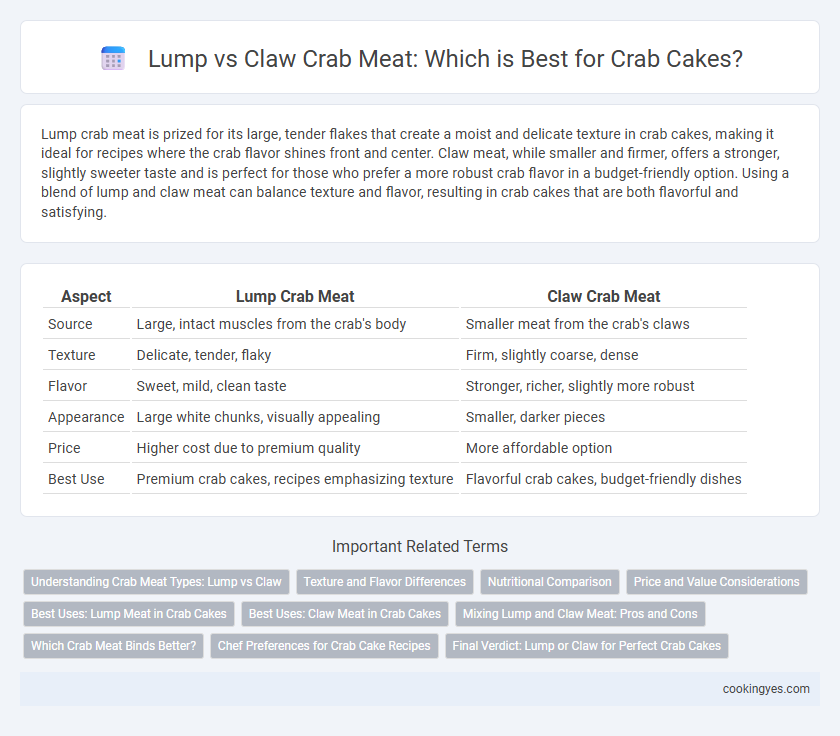Lump crab meat is prized for its large, tender flakes that create a moist and delicate texture in crab cakes, making it ideal for recipes where the crab flavor shines front and center. Claw meat, while smaller and firmer, offers a stronger, slightly sweeter taste and is perfect for those who prefer a more robust crab flavor in a budget-friendly option. Using a blend of lump and claw meat can balance texture and flavor, resulting in crab cakes that are both flavorful and satisfying.
Table of Comparison
| Aspect | Lump Crab Meat | Claw Crab Meat |
|---|---|---|
| Source | Large, intact muscles from the crab's body | Smaller meat from the crab's claws |
| Texture | Delicate, tender, flaky | Firm, slightly coarse, dense |
| Flavor | Sweet, mild, clean taste | Stronger, richer, slightly more robust |
| Appearance | Large white chunks, visually appealing | Smaller, darker pieces |
| Price | Higher cost due to premium quality | More affordable option |
| Best Use | Premium crab cakes, recipes emphasizing texture | Flavorful crab cakes, budget-friendly dishes |
Understanding Crab Meat Types: Lump vs Claw
Lump crab meat consists of large, white pieces from the body of the crab, prized for its sweet flavor and delicate texture, making it ideal for premium crab cakes. Claw meat, darker and more flavorful, has a firmer texture with a slightly stronger taste, often used to add richness and moisture to crab cakes. Understanding the distinct textures and flavors of lump and claw meat helps in selecting the right blend for a balanced, flavorful crab cake.
Texture and Flavor Differences
Lump crab meat features large, firm chunks with a sweet, delicate flavor ideal for premium crab cakes, while claw meat offers a finer texture with a stronger, more robust taste rich in seasoning. The firm texture of lump meat holds well in cakes, providing a satisfying bite, whereas claw meat's softer consistency blends easily, enhancing overall flavor complexity. Choosing between the two depends on whether a subtle sweetness or a more intense, savory profile is desired in crab cake recipes.
Nutritional Comparison
Lump crab meat contains larger, whole pieces of white meat with higher protein content and lower fat levels compared to claw meat, making it a leaner choice for crab cakes. Claw meat features a slightly sweeter flavor and contains more iron and calcium, contributing to better mineral intake. Both types offer essential omega-3 fatty acids, but lump meat generally provides a cleaner texture and superior nutrient density for a healthier crab cake.
Price and Value Considerations
Lump crab meat commands a higher price due to its large, intact pieces and superior texture, offering a premium quality ideal for gourmet crab cakes. Claw meat is more affordable, providing a stronger flavor but a finer, less distinct texture, making it a cost-effective option for budget-conscious recipes. Choosing between lump and claw meat depends on balancing the desired flavor and presentation against the price and overall value for crab cake preparation.
Best Uses: Lump Meat in Crab Cakes
Lump meat, harvested from the larger muscle pieces of blue crabs, offers a tender texture and sweet, delicate flavor ideal for premium crab cakes. Its sizable, moist chunks hold together well during cooking, providing a satisfying bite and an appealing presentation. Chefs prefer lump meat in crab cakes for a luxurious mouthfeel and pronounced crab taste that stands out in every bite.
Best Uses: Claw Meat in Crab Cakes
Claw meat offers a richer flavor and firmer texture that holds up well in crab cakes, providing a more robust bite compared to lump meat. Its darker, more flavorful profile enhances the overall taste, making claw meat ideal for recipes that benefit from a pronounced crab essence. Using claw meat in crab cakes ensures a heartier, more satisfying dish with a balanced texture.
Mixing Lump and Claw Meat: Pros and Cons
Mixing lump and claw meat in crab cakes balances texture and flavor, combining the delicate, sweet lump meat with the firmer, more flavorful claw meat. Lump meat offers large, tender chunks ideal for a premium texture, while claw meat provides a stronger crab flavor and better binding properties. However, using more claw meat may result in a denser cake and may mask the subtle sweetness typical of pure lump meat.
Which Crab Meat Binds Better?
Lump crab meat, consisting of large, intact pieces, offers a firmer texture that binds better in crab cakes compared to claw meat, which is finer and more delicate. The natural cohesiveness of lump meat reduces the need for excessive fillers or binders, enhancing the cake's structural integrity. Claw meat, while flavorful, tends to produce a softer, more crumbly crab cake due to its finer texture and higher moisture content.
Chef Preferences for Crab Cake Recipes
Chefs prefer lump crab meat for crab cakes due to its large, tender chunks that provide a delicate texture and rich flavor, enhancing the dish's premium quality. Claw meat, while more affordable and flavorful with a slightly stronger taste, is often chosen for recipes requiring a firmer texture and a more intense crab flavor. Culinary experts balance these meat choices based on desired texture, flavor concentration, and presentation in upscale crab cake recipes.
Final Verdict: Lump or Claw for Perfect Crab Cakes
Lump crab meat, known for its large, tender pieces and sweet flavor, creates a delicate texture ideal for premium crab cakes, while claw meat offers a stronger, more intense flavor with a firmer texture that holds well in recipes requiring a bolder taste. Choosing lump meat results in lighter, more refined crab cakes favored in gourmet preparations, whereas claw meat provides a budget-friendly option without sacrificing rich crab essence. The final verdict depends on desired texture and flavor intensity, with lump meat preferred for elegance and claw meat for affordability and robustness.
Lump vs Claw Meat for crab cakes Infographic

 cookingyes.com
cookingyes.com